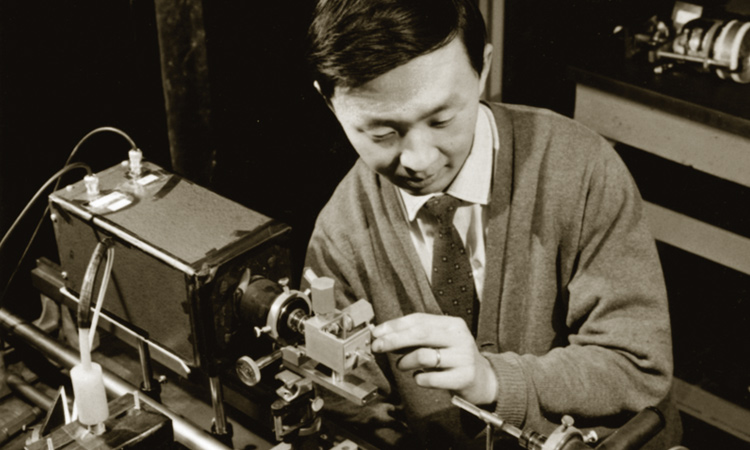 Charles Kao measuring the transparency of fused silica at Stanford Telecommunications Labs in Harlow, U.K. [Nortel and BNR Eurorpe/Courtesy of Jeff Hecht]
Charles Kao measuring the transparency of fused silica at Stanford Telecommunications Labs in Harlow, U.K. [Nortel and BNR Eurorpe/Courtesy of Jeff Hecht]
Communications seemed an obvious use for the new-born laser in 1960. Telephone traffic had been growing for many years, and television had become commonplace. Telecommunications carriers seemed to have an endless thirst for bandwidth. Long-distance telephone traffic had outgrown copper cables, and since the early 1950s they had been installing chains of microwave relay towers to handle the growing load.
Even that wasn’t enough. The telephone industry was developing a new generation of microwave systems operating at tens of gigahertz to carry future traffic. Optical frequencies were hundreds of terahertz, so laser light promised the vastly greater bandwidth that the industry required for its long-term ambitions. One example was the “Picturephone”—a futuristic video telephone system in development at Bell Labs—which would require the equivalent of 96 voice phone circuits.
Optical frequencies were hundreds of terahertz, so laser light promised the vastly greater bandwidth that the telephone industry required for its long-term ambitions.
Once lasers became available, communications researchers began studying laser transmission in various media. Air proved far from ideal, so they tried optical counterparts of the hollow metal waveguides in development for 60-GHz transmission. When future OSA Fellow Ivan Kaminow, then a young Bell Labs scientist, suggested using optical fibers as waveguides to transmit light, his boss, Rudolf Kompfner, asked him how transparent the best available glass was.
The clearest glass Kaminow could find listed in the Handbook of Chemistry and Physics was silica, with losses of about one dB/m. That meant that optical power would drop a factor of ten every ten meters, so Kompfner told him to forget it.
It seemed a sensible decision at the time. A few years later, though, the late Charles Kuen Kao would ask a different question: How clear can glass actually be made? The answer he received would lead him to a technological revolution—and a Nobel Prize.
The 1960s telephone industry
Kao worked for Standard Telecommunications Laboratories (STL), a British research center owned by the International Telephone and Telegraph Corp. It was a different world from Bell Labs, the world’s leading and best-funded industrial research laboratory, which was owned by the U.S. giant AT&T, the world’s largest telephone company. Though STL’s parent company was large by British standards, its main customers were the comparatively stodgy government postal, telephone and telegraph agencies that operated most of the national phone system.
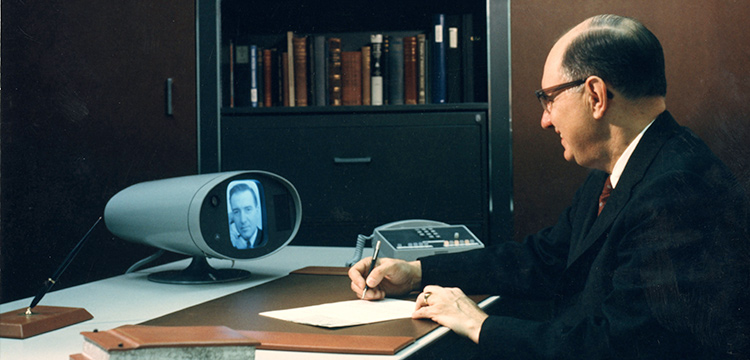 L.H. Meacham talks on the experimental Picturephone at Bell Labs in Holmdel, N.J., USA, 1964. [Reused with permission of Nokia Corporation and AT&T Archives]
L.H. Meacham talks on the experimental Picturephone at Bell Labs in Holmdel, N.J., USA, 1964. [Reused with permission of Nokia Corporation and AT&T Archives]
In 1960, the U.S. telephone industry reached 80 percent of households, double the 40 percent it had served in 1940. Long-distance traffic, which carried premium prices, was growing strongly, and AT&T had introduced the stylish Princess phone for home use in 1959. Picturephone, which debuted at the 1964 World’s Fair in New York, was a bold bet that the American public would replace tired old voice phones with new video phones, just as home entertainment had shifted from radio to television.
The U.S. government had long regulated the phone system as a natural monopoly, limiting prices but guaranteeing a profit and requiring that AT&T invest part of its income in research. That research budget made Bell Labs the leader in developing the new 60-GHz transmission system, called millimeter waves because of their 5-mm wavelength. The 5-cm waveguide tubes transmitted multimode, and had to be laid very carefully on sweeping arcs, like railroad tracks, to limit losses. But the U.S. had wide-open spaces available, and costs weren’t a showstopper for a regulated monopoly. When the laser came along, Bell naturally thought of hollow optical waveguides.
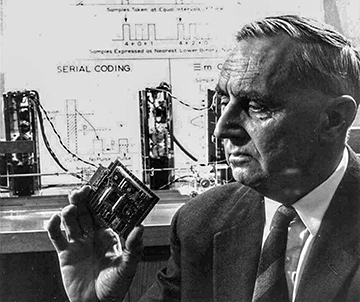 Alec Reeves of STL initially led the optical research team there. [Courtesy of Mary Epworth]
Alec Reeves of STL initially led the optical research team there. [Courtesy of Mary Epworth]
STL thinks optics
The millimeter waveguides did not impress STL’s resident technology guru, Alec Harley Reeves. Born in 1902, he was famed for patenting pulse-code modulation in 1938 and developing jamming-resistant radar for nighttime bombing during World War II. He was eccentric, but management recognized him as a visionary engineer.
Reeves thought light, with its higher frequency, would make a better communications system than millimeter waves, and had a small group investigate the prospects. Charles Eaglesfield calculated that that a one-inch tube with a silvered interior would suffer attenuation of only 1.6 dB/km, but experimental losses clocked in at more than 125 dB/km. Murray Ramsay proposed building a confocal optical waveguide by equally spacing a series of lenses along a tube, an idea Bell Labs also pursued.
STL had a separate group headed by Antoni Karbowiak working on millimeter waveguides, which Kao joined in 1960. However, upper management shut down that project after a couple of years, deeming millimeter waveguides an unprofitable prospect in space-constrained Britain. Instead, they turned their attention to smaller systems to carry multiplexed phone calls between towns or suburbs, and transferred Karbowiak and Kao to work on optical waveguides.
The discovery of single-mode transmission in optical fibers, published in a pair of 1961 JOSA papers by OSA Fellow Elias Snitzer, intrigued Karbowiak. As a theorist, Karbowiak liked the simplicity of single-mode transmission and recognized that fibers were the optical counterpart of dielectric waveguides for radio waves. He also understood that multimode transmission underlay the losses in millimeter waveguides, and wondered if single-mode transmission would make fibers good optical waveguides. To find out, he asked Kao, then 30, and George Hockham, just 25, to calculate the properties of single-mode fibers.
The two first looked at the simple case of a bare glass fiber guiding light along its outer surface, where it would experience little loss because most light stayed in the air. The large refractive-index difference between glass and air, however, would allow single-mode transmission only if the core diameter was less than 0.2 microns—too thin to handle or couple light into. Single-mode transmission of visible wavelengths was possible, however, in a 4-micron core, if it was clad with glass with a refractive index just one percent lower than the core. Yet that design had its own problem: it would shift light transmission into the glass core of the fiber, where attenuation would limit transmission distances.
As an alternative, Karbowiak designed a bare, ribbon-like waveguide a fraction of a wavelength thick but many wavelengths wide, which he calculated could guide a single optical mode along its center with absorption losses of only a few dB/km. He asked Kao and Hockham to make and test the ribbons. Then the University of New South Wales offered Karbowiak a job as chair of its electrical engineering department, and he emigrated to Australia. Before he left, he warned Kao, “you’re off on a wild goose chase” with optical fibers.
Kao found himself the head of a two-person group. Tests of the ribbon waveguide did not go well. When put on a curved support, the ribbon sprayed red light from a helium-neon laser all over the lab. “That was the end of the surface waveguide, because [with those losses] there was no way you could use it,” Kao told me in 1995.
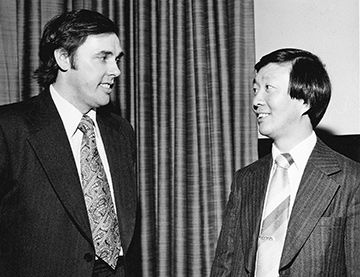 George Hockham and Charles Kao at the presentation ceremony for the 1978 Rank Prize, which they shared. [Courtesy of Mary Epworth]
George Hockham and Charles Kao at the presentation ceremony for the 1978 Rank Prize, which they shared. [Courtesy of Mary Epworth]
Asking the right questions
That left Kao and Hockham with clad single-mode fibers as their best option. For intercity phone links, they needed to reduce fiber loss to no more than 20 dB/km. They needed to identify the main causes of attenuation and greatly reduce their impact.
One concern was waveguide structure. The millimeter waveguide suffered serious losses from seemingly minor bends and irregularities in the waveguide itself, so Hockham calculated what losses similar irregularities would cause in glass fibers. His results predicted little impact. To confirm that, he assembled tubular copper waveguides that varied in diameter along their lengths, then measured the loss of microwaves of the same relative size as light in a fiber. The measured losses were encouragingly low.
Kao, meanwhile, focused on a second concern: glass transparency. “I was seeking the answer to the question, ‘What are the loss mechanisms and can these mechanisms be totally removed?’ It appeared that no one had really asked this question before,” Kao wrote in “Historical Notes on Optical Fiber Communications,” an unpublished memoir. In fact, no one had needed to ask that question before, as glass with attenuation of 1 dB/m had been perfectly adequate for other uses—imaging bundles of fibers, for example, were no longer than a few meters.
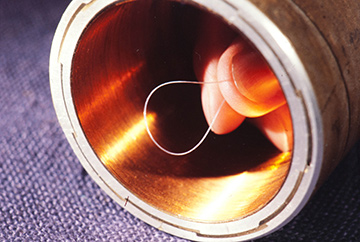 End of a section of long-haul microwave waveguide, with tightly bent optical fiber being shown to emphasize the difference in flexibility. [Courtesy of Mary Epworth]
End of a section of long-haul microwave waveguide, with tightly bent optical fiber being shown to emphasize the difference in flexibility. [Courtesy of Mary Epworth]
Building the case for fiber
The STL team set out to quantify the two types of light loss inside glass, absorption and light scattering, and to learn how they could be reduced. Regarding scattering, Eaglesfield queried Aniuta Winter, a French researcher who had published several papers on glass properties. She estimated that scattering losses in quartz were less than 5 dB/km, which was encouraging news. She probably was the person who pointed Eaglesfield or Kao to a 1956 paper (which Kao later cited) by Robert D. Maurer of Corning Glass Works, USA, which estimated scattering of 1-micron light in glass at about 1 dB/km.
Kao’s questions about absorption led him to Harold Rawson, a professor in the glass group at the University of Sheffield, U.K., who explained that impurities caused the absorption. A student, Fiona Newhouse Steele, was in the process of writing a doctoral dissertation on the strongest absorber, iron, the source of the greenish color of bottle and window glass. Rawson mentioned a paper Steele had written with R. W. Douglas describing her observations, and told Kao that purification should reduce glass absorption below 20 dB/km.
That was enough for Kao to build a case for fiber optic communications. He gave a talk at the Institution of Electrical Engineers (IEE) in London in January 1966, and with Hockham wrote the now-famous paper that appeared in Proceedings of the IEE in July 1966. An STL press release said that the single-mode fiber’s 1-GHz bandwidth could carry 200 television channels or 200,000 telephone conversations.
But the news only made a handful of publications, including Wireless World in the U.K. and Laser Focus (then a biweekly newsletter) in the U.S. The rest of the world thought the future of communications was satellites, Picturephone, millimeter waveguides, and the hollow confocal optical waveguides that Bell Labs described in the January 1966 Scientific American.
Hidden figures of glass science
Aniuta Winter
When I wrote City of Light: The Story of Fiber Optics in the 1990s, very few women were part of the story. So I made a point of mentioning that Kao’s group had consulted with a “Mme. Winter” about light scattering in glass. However, I did not investigate her further until I looked deeper into how Kao had studied the attenuation of glass.
Kao’s comments indicated that Winter was an expert on glass, and indeed she was. Born in 1907 in Poland, Aniuta Winter went to France to study and wrote a thesis published in 1938. She took French citizenship and married Stanislas Klein. The two listed themselves as French physicists of Jewish origin born in Poland when traveling to the U.S. during World War II, when they carried U.S. passports. Winter continued working on glass, presenting papers at three American conferences in 1943 and 1944.
They later returned to France, where she became an authority on glass, publishing extensively both as Aniuta Winter and as Aniuta Winter-Klein. Glass had long been an important industry in France, and she worked at the industry-supported Institute des Verres (Glass Institute) before the French National Center for Scientific Research (CNRS) created the research-oriented Laboratoire des Verres (Glass Laboratory) and named her the director.
Maria Calvo of the Complutense University of Madrid, who joined the glass lab in 1969, recalled Winter as a woman of strong scientific stature, and who was known to all as “Mme. Winter.” In 1982, after her death, the French Academy of Sciences established the Aniuta Winter-Klein Prize, which is awarded every three years in her honor.
Fiona Newhouse Steele
Fiona Steele regarded herself “as a little cog in a big wheel” when she was involved in the glass research that helped Kao zero in on the impurities behind glass absorption. She enjoyed the research, but had little concept of where Kao’s ideas would lead.
Looking back, she wrote me in an email, “soon after completing my Ph.D., my interests veered to knowing a little about a lot rather than a lot about a little, and my subsequent career was a very diverse one, ending up rather surprisingly in the social sciences.” Now retired after work in both government and industry, she remains interested in science.
One key person did pay heed to Kao, however: John Bray, the newly named director of the British Post Office research station in London. He put a crusty but visionary engineer named F.F. Roberts in charge of fiber communications. Roberts told a visitor from Corning of his interest, and the word was passed along to Maurer in Corning’s glass research lab, who began investigating.
A crucial experiment
Meanwhile, STL expanded its little fiber group, and gave Kao money to travel the globe to drum up interest. “I was trying to sell a dream,” he told me in 1995. He visited many glass researchers, but his highest-stakes trip was to Bell Labs, whose interest he considered essential to get fiber communications off the ground. Yet the Bell officials thought that solids were not transparent enough for use in communications. They said that they would talk to their materials scientists, but kept the institution’s optical communications research focused on a new confocal waveguide that used flowing-gas lenses to focus light along the tube.
The best way to convince the skeptics, Kao decided, was to measure the bulk loss in the purest available glass. In those days that was a challenge. The precision of optical measurements was limited, and Kao was trained in electrical engineering rather than optics or metrology.
First, he tried to measure loss in a 20-cm piece of high-purity glass with a single-beam spectrophotometer, but the instrument’s resolution was limited to detecting attenuation of 0.01/cm, or about 4000 dB/km. Then, he and Merwin Jones developed a new two-beam spectrophotometer and began a series of painstaking measurements on samples of fused silica, the purest glass they knew.
They spent months performing the experiments, analyzing the results, and working through the details. At first it looked too good to be true—the glass seemed perfectly clear, with zero loss. Kao and Jones knew that that would not convince the skeptics, so they went back and checked everything. Further measurement and analysis put the loss at about 5 dB/km for their best samples. They carefully bulletproofed the findings and wrote them up.
“Kao gave everybody a jolt”
Kao and Jones succeeded brilliantly. Their technique pushed the measurement sensitivity frontier for glass attenuation, and their paper, published in April 1969, convinced many skeptics. “Kao gave everybody a jolt,” said Dave Pearson, who had been running a low-level fiber project in Bell Labs’ materials group at Murray Hill, N.J., USA. “That was the first practical measurement which said, Hey, you’re not just whistling Dixie.” Bell added several people to Pearson’s fiber group and started getting serious about low-loss fiber.
Actual low-loss fibers remained elusive—but only briefly. Bell Labs, the British Post Office and other groups focused their efforts on making low-loss fibers by purifying compound glasses rather than starting with the fused silica Kao had used in his experiments. One reason was that compound glasses melt at much lower temperatures than the highly purified silica, making processing easier. The other was the challenge of making the glass into fibers with a core that has a slightly higher refractive index than the outer cladding. Pure silica has a refractive index lower than almost all other materials used in glass, so dopants would have to be added to the core to make a fiber. But dopants increase fiber loss.
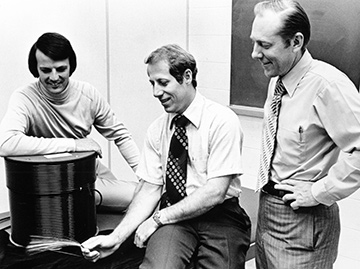 Peter Schultz, Don Keck and Robert Maurer pose at Corning after making the first low-loss fibers. [Corning Incorporated, courtesy of AIP Emilio Segrè Visual Archives, Hecht Collection]
Peter Schultz, Don Keck and Robert Maurer pose at Corning after making the first low-loss fibers. [Corning Incorporated, courtesy of AIP Emilio Segrè Visual Archives, Hecht Collection]
It was Corning that solved those problems. Bob Maurer had decided to start with fused silica. He brought in two bright young physicists, future OSA Honorary Member Donald Keck and OSA Senior Member Peter Schultz, along with Corning veteran Frank Zimar, who had experience with fused silica and a furnace hot enough to melt it. Maurer announced their breakthrough low-loss fiber at a London meeting dominated by papers on millimeter waveguides at the end of September 1970. Fiber optics came up in a discussion session wrapping up the meeting.
Most attendees were confident millimeter waveguides—the “pipes of progress”—would be the next generation of communication systems. But Richard Dyott, a young Post Office engineer working on fibers, stood up and proclaimed “I’m quite happy for you to lay the waveguides, and we will come along later and fill them with optical fibers.” He was not optimistic enough. Millimeter waveguides were never deployed, and in the 1980s fiber became the backbone of the global telecommunications network.
Perfect timing
Kao and Hockham’s 1966 paper proposed using fiber in one part of the telephone network, cables carrying hundreds of voice circuits over routes spanning around 10 kilometers between local switching offices. In retrospect it seems a cautious goal, but at the time it was reasonable.
The visionary Alec Harley Reeves saw broader potential applications. He predicted that in 2020 fiber optic networks would carry 300 Mbit/s to homes and 10 to 20 Gbit/s on backbone systems. He envisioned long-haul fiber cables on land and undersea, with optical amplifiers spaced at 2-km intervals. (He also foresaw pocket mobile phones, and computerized information retrieval replacing libraries.) Now six pairs of fibers in the Pacific Light Cable can carry up to 144 Tbit/s a third of the way around the world, between Hong Kong and southern California, to sustain cloud computing.
Technologies can be ahead of or behind their times. Reeves was ahead of his time when, in 1938, he patented pulse-code modulation, which encodes analog signal amplitudes as a series of digital pulses, allowing telephone calls to be multiplexed together and amplified without distortion. But in an era of vacuum tubes rather than transistors, that concept was ready long before technology was available to implement it.
Fiber optics for imaging, in contrast, was behind its time. Glass fibers were invented in the 1800s, and a patent on bundling the fibers together to transmit images was filed in 1927 by C.W. Hansell of RCA. Heinrich Lamm, a German medical student, assembled and demonstrated an imaging bundle in 1930. But no one followed up their work until the 1950s, when the clad fibers became available to prevent light leakage.
The timing of Kao’s invention of fiber optic communication was almost uncannily perfect. He had tracked down the right glass experts and asked the right questions to recognize the potential clarity of glass. Then, he had meticulously made measurements far more precise than anyone else had attempted to show that fused silica was as good as he had predicted. In Corning he found a company with glass technology good enough to make fibers that met his loss goals. Within two years after its first low-loss fiber, Corning had reduced the loss to 4 dB/km and greatly improved fiber strength by changing the dopant in the glass to germanium. In 1978, Masaharu Horiguchi and colleagues at Nippon Telegraph and Telephone (NTT) made fibers with an amazingly low loss of 0.2 dB/km at 1550 nm, close to the theoretical limit from scattering.
Other pieces fell quickly into place. Future OSA Fellow Zhores Alferov at the Ioffe Physical-Technical Institute in St. Petersburg (then Leningrad), USSR, demonstrated the first diode laser able to emit a continuous beam for more than a few seconds at room temperature, just a few months before Maurer reported the first low-loss fiber. Bell Labs then spent years improving semiconductor processing to make diodes that could last a million hours. Engineers developed splices and connectors that aligned hair-thin fibers so well that only a tiny fraction of the light was lost.
Single mode vindicated
The first generation of fiber optic systems in the 1970s made one important deviation from Kao’s plan. He preferred single-mode fiber because it offered better light guiding and higher transmission speed, but Bell Labs had pushed for graded-index multimode fiber because its larger 50-micron core promised easier fiber interconnection. AT&T won that round. Its first round of fiber systems connected switching offices, as Kao had planned, but used multimode graded-index fiber, with each fiber carrying 45 Mbit/s, the digital equivalent of 672 voice circuits.
The multimode fiber era would be short, however. Single-mode fiber technology was maturing rapidly. The shift to the lower-loss 1300-nm window increased single-mode core size, easing coupling problems. But the biggest advantage was that single-mode fiber could carry more bandwidth—initially hundreds of megabits per second—over longer distances than graded-index fiber. By the end of 1982, MCI had decided to build its national 400-Mbit network with single-mode fiber. Kao’s choice of single-mode fiber was vindicated.
As we approach 2020, the power of Charles Kao’s vision has leapt beyond anything that he or Reeves could have imagined half a century ago. It’s revolutionized our technological society. And it could not have grown so fast, or so strong, if Kao had not asked the right question—not what can we do today, but what might be possible tomorrow.
Jeff Hecht is an OSA Fellow and freelance writer who covers science and technology.
This article draws largely on research for the author’s previously published book City of Light: The Story of Fiber Optics (Oxford, 1999). A list of additional references and resources can be found at www.osa-opn.org/link/kao-fiber-vision.
